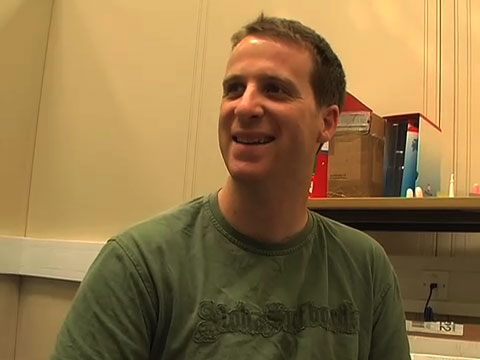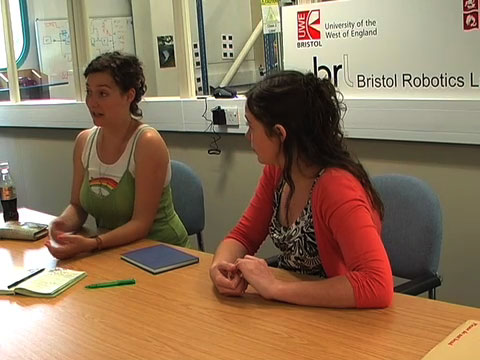Bristol Robotics Laboratory
Jimmy and Tobie recently visited the Bristol Robotics Laboratory, based at a new facility in Bristol Business Park. The lab focusses on bio-engineering and intelligent autonomous systems, and aims "to understand the science, engineering and social role of robotics and embedded intelligence" (more on the BRL home page).

Chris Melhuish is the director at BRL, which has over 50 members of staff and students. With this in mind, rather than focus on a single researcher, a number of staff and students were kind enough to talk about their roles at the BRL. Thanks to Peter Walters, Peter Jaeckel, Paul Bremner, Christopher Bytheway, Craig Chorley and Ioannis Ieropoulos for providing accounts of their work. Thanks also to Claire Rocks and Emily Dawson from UWE's Science Communication Unit, who helped set up the visit, and provided an account of public engagement with engineering research. More about the Walking With Robots network here, which is the focus of this discussion.
Clips from the conversations with BRL staff and students about their research form the fist section of this page, with material from interviews with Claire and Emily about public engegement form the second section.
These clips represent a small selection of a large portfolio of research projects currently being carried out within the laboratory. The BRL website has more details of research taking place in the lab.
Click the titles or the images to see movies, Quicktime 7 is required.
Interview with Chris Melhuish

Collective Robotics (14.6 MB)
How do you get a lot of dumb things doing something smart - social insects provide inspiration for collective and decentralised robotic systems.
A short history (9.6 MB)
The lab has been around in various forms for over 12 years, in which time the term robot has had different connotations.
Research Portfolio (7.5 MB)
With about 50 people associated with the lab, there is a broad and multi-disciplinary research portfolio.
Use and risk (15.7 MB)
Robots powerful enough to be useful, are likely to be able to cause harm. Knowledge from other disciplines might be deployed to build safe robotic systems.
Human-like (3.6 MB)
Robots that at a research stage resemble humans, might later be rearranged into non-human forms to better suit the application.
Rehabilitation (4.4 MB)
Assistive robots might also be used for medical rehabilitation.
Continuum (5.1 MB)
The potential for building biological systems, puts robots and people into a broad continuum where differences are less clear.
Car-life (3.2 MB)
To what extend do are we a part of the systems we use - for example when we drive a car?
Ethics (3.7 MB)
The ethical contexts of the research at the lab are frequently discussed.
Smart materials (11 MB)
Rapid prototyping might develop so that sensors and processors are formed within the fabricated object.
'Engineering' (7.7 MB)
Engineering is a vague and degraded term.
Connotations (12.1 MB)
The term engineering has connotations that are outdated, and misrepresent what engineers do.
Students (6.1 MB)
Undergraduate engineering might benefit from being associated with more compelling applications.
Japanese context (7.7 MB)
The construction of new engineering facilities in Japan should act as a model for the UK.
Hubris (7 MB)
The UK might do well to look beyond it's short-term successes within the service industries.
back to top
Research at the BRL
Peter Jaeckel on artificial empathy (4.7 MB)
Peter describes a human-like robot that is used to explore artificial empathy. He demonstrates a sequence of expressions, and describes potential applications.
Craig Chorley - humanoid hands (13.1 MB)
Craig is developing humanoid hands, which draw upon insights into biological techniques for sensing and movement.
Christopher Bytheway - rapid prototyping (13.1 MB)
Chris describes how the lab's research directions are resourced. Rapid prototying machines are used to build components for use within research projects.
Ioannis Ieropoulos - energy autonomy (13.1 MB)
How robots can autonomously generate their own energy from the environment. The EcoBot is a hybrid of electronics and biology.
Designing and making in research (7 MB)
A conversation about how lessons can be learnt from the process of making, and how the outcomes of making can frame a discussion about the role of a technology (some references for these comments).
Peter Walters' research (12 MB)
Peter is interested in developing materials with behaviours that allow their properties to change depending on enviroment. He also reflects upon his design process.
Public Engagement of Enigineering
Note: The following clips took place before the clips above, but arguably are more useful here, after a presentation of the research going on in the lab...
Claire Rocks and Emily Dawson - Science Communication Unit (5.3 MB)
Claire and Emily describe their roles at the Science Communication Unit where they support and evaluate the public engegement output of a network of UK Robotics labs.
Emily and Claire - backgrounds (7.5 MB)
An overview of educations and experinces leading up to their current work. Contrasting backgrounds in humanities and physics converging in shared interests in public engagement.
Public engagement - what's in it for me? (16.2 MB)
While engagement might not be appropriate for all scientists and engineers, there are some good reasons to do public engagement work.
Models of engagement (14.8 MB)
How public egagement of science and engineering gets done depends on the content and the audience. It might also be worth considering what role engagement should perform, and how this role might be informed by policy or academia.
Public as participants (13 MB)
Members of the public are seen as participants in engagement activities, where the focus is on facilitating an active role.
Perceptions of a robots (5.1 MB)
There is a gap between the outcomes of current robotics research and popular representations of robots, which can be addressed by engagement activity.
Designers role in science (5.3 MB)
Some discussion on the role of design in engineering, and some reflection on what the real differences between design and engineering are.
Intervew by Jimmy and Tobie on 7th August 2007, edited by Susana.












